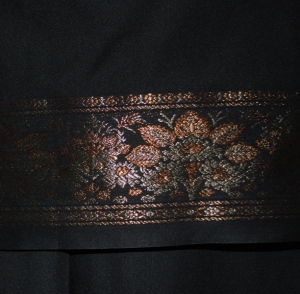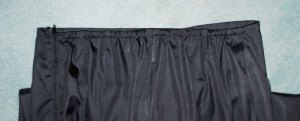Earlier this week I presented Veronica to you and mentioned Jenny. Jenny is now ready for you.
If you haven’t read my last post, I will explain who they are. Veronica and Jenny are two patterns produced by The Tailor’s Apprentice. Veronica is a 1940’s evening gown with a capelet and Jenny is a sailor suit, also from the 1940s. Lorna McKenzie is the designer and she has used actual clothing from the WWII years to draft these patterns. These were clothes owned by Miss Page. Lorna tells her story on her website. She also has 3 other 1940s patterns at the moment: a wedding dress, a day dress and an overall type thing! There will be more.
It took me a couple of days after downloading the digital patterns from Lorna to decide which fabric from my stash I would use for Jenny. It was a cinch choosing the fabric for Veronica!!! That’s why I started with that pattern. In the end, I chose to use another of my saris to make into the sailor suit. Once it was done, I was amused to observe that I had turned the formal gown Veronica into a day dress and the casual sailor suit into a dressier outfit, as you will see. Asi es la vida!!
By the way, digital patterns are as easy to use as store-bought ones. After receiving your file by e-mail, you print it out and re-assemble it, a bit like a puzzle, and then proceed with cutting the paper up and then cutting your fabric from it. When I say *like a puzzle* it actually is easier than that! All the pattern pieces are logically and clearly numbered, so all you need to do is place them in rows and columns.
So, back to Jenny in a sari. I love using saris for many of my clothes: the fabric drapes so nicely! And the colours! and the metallic thread borders! Having said that, this sari is black with pewter and copper metallic thread borders.
The sailor suit consists of a short-sleeved top complete with little square scarf thing at the back that ties at the front and a pair of trousers. The very attractive design component of this suit is how the top is yoked at the front. It has a pretty swooping curve. The pants are straight.
I started with the top as it is more *involved*. I prefer to do the difficult thing first. Once again this pattern is in three sizes. I cut everything in the large size, for added comfort. There are two small darts on the blouse. The sleeves also have darts or pleats at the shoulder which give them a slight puff. The ’40s’ puff!!
The instructions are clear and precise and assembly went well. Here are the things I changed though, customizing it to my preferences. First: I lengthened the top. In the pattern picture, it is a short blouse which just covers the trouser top. As I am a *certain* age, I prefer my dressier tops to be tunic length: ending about 2/3 way up my thigh. This entailed widening the hemline by simply lengthening the sidelines a little and I chose to make a slit on either side for more comfort.
I also wanted my sleeves to be full length. But they can be rolled very flat for times I might want it shorter because I made them straight down.
Same as for Veronica, I omitted the side seam zipper. I just didn’t feel there was a need for it, for me, and besides, I don’t like the feel of a zipper on the side there. It stiffens the fabric when using a soft one like sari material. The last change I made was to keep the scarf thing apart from the blouse, rather than sewing it to the neck edge. The instructions guide you through using a bias tape (made from the same fabric and for which a pattern piece is supplied) to finish the neckline. I still used the bias tape. I added one thing: because I was using a sari with a beautiful border, I wanted some of that around the neckline. I had to place it correctly in line with the edges of the neckline and make it stop at the top of the border that was part of the yoke. See picture.
The pants are only four pieces. I widened the pants, to really take advantage of the border; in addition, I like wearing skirts in summer but I find them inconvenient at times. So lately I have been making pants wide at the bottom and which are fitted at the top and they look like skirts (or Palazzo pants) because I almost always use soft and flowing fabrics. Comfort and elegance all wrapped in one, if I do say so myself! 🙂
There is no waistband but an inside facing that helps keep things tidy and flat. They have a side zipper and because I liked the fitted look of these, I did use a zipper rather than my usual elastic waist. The well-written instructions guide you through that installation smoothly. There are two small darts on the trouser back pieces which make it lie completely flat to your rear end.
The last thing I did was make a narrow casing with the facings and the pants in the back. Here’s how: after attaching the facings to the pant top, I tacked down the facings at all the seams and then sewed across the back, from side seam to side seam, about 1/2 in. down from the top. Then I slid the elastic in there, sewing it down on either side seam. I cut my clothing slightly bigger than I actually need for comfort. Sometimes that makes the pants droop. So by putting that narrow little elastic in the back, it holds the trousers up snugly at your waist(or wherever) and makes the front look taught and smooth, without bunching the back at all. There is more space around the middle and bum for sitting in that way too. This *flatness* is also necessary when wearing a lightweight fabric top. The tunic shows no bunches or anything when you are wearing it. Of course in the picture it is slightly gathered: cut the elastic just long enough for it to stretch gently and it will then lie flat on you.
This pattern has extra long legs because Lorna offers the option (with instructions) of making cuffed pants as was stylish in the 1940s, even for women. Again, I wanted the sari border to be the decoration at the bottom, so I cut the pants to my usual length. Placing the pattern pieces correctly on your borders is crucial: I lined up the pattern grainline on the cross-grain(that is the weft of the fabric, as opposed to the grain which is on the warp. They cross at 90 degrees.) in order to get the border at the bottom. Come to think of it, that’s what I did for the sleeves too: put the sleeve hem on the border and the cross-grain of the fabric became the grainline on the pattern.
As the end of assembly was nearing, I realized that this outfit would be a very appropriate evening ensemble, not very formal but *nice*. I also saw that it looked a lot like an Indian set, of course, because I used the sari and it’s embellished borders to the max! The last thing I made was a wrap with the last bits of the sari and I can use that on cooler nights.
So in the end, I made Veronica the evening gown into a day dress and Jenny the day outfit into an evening set. Twas ever thus! While discussing the changes I made with Lorna, she pointed out that the original pattern called for a tunic length top, but that *the hipsters thought it would be better shorter*, so she made a short top for this pattern. I simply returned the pattern to its original design!














I adore how you have used a saree, it looks super elegant and is soooo 30s ‘pyjama’ style, beautiful work again and very ‘make do and mend’, or as my mum used to say ‘cut your suit to suit your cloth’ 🙂
Thanks for being a tester reviewer!
A pleasure, surely!! Thank you Lorna for your compliments! 🙂
It looks wonderful, great use of the border material !
Sweetie, it’s beautiful! I look forward to seeing it (and maybe you, in it!) the next visit!
Not before? Not before my planned wearing? Oh dear!!